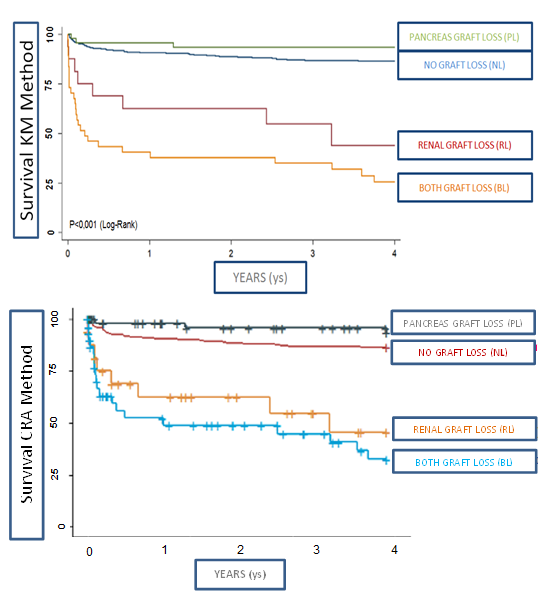Four-Year Patient Survival After Simultaneous Pancreas-Kidney Transplantation According to Graft Status Using Kaplan-Meier Survival Method and Competing Risk Model
1Renal Transplantation, Hospital do Rim - Fundação Oswaldo Ramos, Sao Paulo, Brazil, 2Federal University of Sao Paulo, Sao Paulo, Brazil, 3Kidney-Pancreas Transplantation, Hospital do Rim - Fundação Oswaldo Ramos, Sao Paulo, Brazil
Meeting: 2022 American Transplant Congress
Abstract number: 1165
Keywords: Graft failure, Kidney, Kidney/pancreas transplantation, Survival
Topic: Clinical Science » Pancreas » 65 - Pancreas and Islet: All Topics
Session Information
Session Name: Pancreas and Islet: All Topics
Session Type: Poster Abstract
Date: Sunday, June 5, 2022
Session Time: 7:00pm-8:00pm
 Presentation Time: 7:00pm-8:00pm
Presentation Time: 7:00pm-8:00pm
Location: Hynes Halls C & D
*Purpose: Aim of this study is to compare the patient survival submitted to SPKT according to the status of graft losses, kidney, pancreas, or both four years after transplantation.
*Methods: This is a retrospective, longitudinal and observational study that enrolled 432 patients submitted to SPKT at Hospital do Rim between 2000 and 2015. The final date follow-up was December 2019. The patients were categorized into four groups according to the graft status: renal graft loss (RL), pancreas graft loss (PL), both grafts losses (BL), and no graft loss (NL). 1- and 4-year patient survivals were analyzed by Kaplan-Meier and competing risk model. The association between graft loss and patients’ survival was estimated by univariable and multivariable models thorough Cox regression, considering NL as a reference group.
*Results: The frequency of patients and time to graft loss according to groups were: 3.7% for RL, in 14.7 months; 10.6% for PL, in 0.67 months; and 8.6% for BL, in 1.5 and 1.37 months for the pancreas and renal graft losses, respectively. After four years of follow-up, 77.1% of patients had both functioning grafts. The 1- and 4-year patients’ survival by Kaplan-Meier were 85.8% and 80.7%, respectively, with no differences between PL and NL, 86.5% e 93.4%; however, they were significantly higher than BL and RL, 25.4% and 43.7%, respectively (P<0.001). The age-adjusted risk of death was associated with RL (HR=5.70; P<0.001) and BL (HR=9.60; P<0.001). The results of 1- and 4-year patient survivals by competing risk model were near to those observed by the Kaplan-Meier method for RL, PL, and NL; however, for BL, the survival probability was higher when analyzed by competing risk: 40.5% vs. 52.4%, and 25.4% vs. 32.6%, one and four years, respectively. Similarly, in the Cox regression by competing risks, RL (HR= 5,09; P<0,001) and BL (HR=9.65; P<0,001) significantly increased the likelihood of patients' death in four years of follow-up.
*Conclusions: The renal graft loss or the losses of both graft, kidney, and pancreas significantly impacted the survival probability of patients submitted to SPKT four years after transplantation, and this pattern was observed as by Kaplan-Meier method, as by competing risk model.
To cite this abstract in AMA style:
Alfaro LA, Viana LA, Cristelli MP, Rangel EB, Meirelles R, Tedesco H, Medina J. Four-Year Patient Survival After Simultaneous Pancreas-Kidney Transplantation According to Graft Status Using Kaplan-Meier Survival Method and Competing Risk Model [abstract]. Am J Transplant. 2022; 22 (suppl 3). https://atcmeetingabstracts.com/abstract/four-year-patient-survival-after-simultaneous-pancreas-kidney-transplantation-according-to-graft-status-using-kaplan-meier-survival-method-and-competing-risk-model/. Accessed December 13, 2025.« Back to 2022 American Transplant Congress

